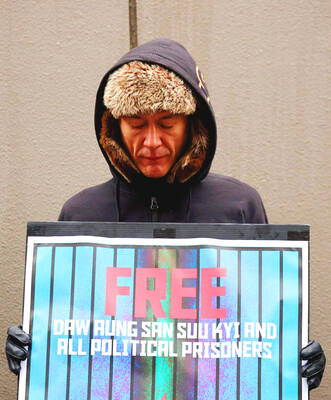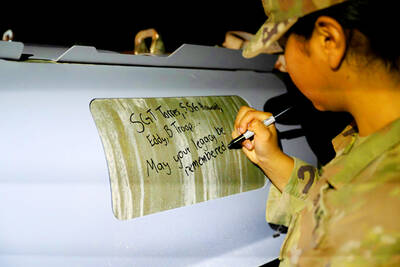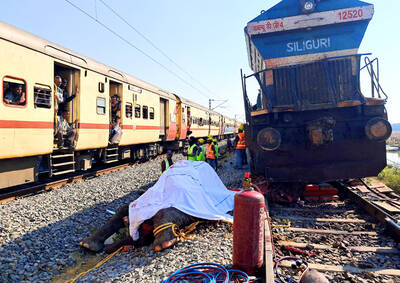A senior Iranian pro-reform cleric has urged voters in next week’s election to oust hardline Iranian President Mahmoud Ahmadinejad, saying his government has failed to improve the economy for the people.
“I will vote in the election and I urge all eligible voters to do the same, to see whether we can change the situation,” Grand Ayatollah Yusef Saanei said at his office in Iran’s clerical nerve-center of Qom.
The interview was conducted in the presence of a Ministry of Culture and Islamic Guidance official because of the sensitive nature of Saanei’s pro-reformist views.
A disciple of Iran’s revolutionary leader Ayatollah Ruhollah Khomeini, Saanei held two prominent posts in the early years of the Islamic republic formed by the toppling of the US-backed shah in 1979.
He was one of the six clerics on the powerful Guardians Council, the 12-member body that vets legislation and election candidates. Khomeini also appointed him Iran’s public prosecutor from 1983 until 1986.
“The revolutionary principles of the Imam [Khomeini] still continue, but many features have changed during the ninth government” headed by Ahmadinejad, the Shiite cleric said, toying with a silver-topped walking stick.
“Several skilled managers were sidelined, inflation and unemployment is making the people poorer ... we sold a barrel of oil at US$130, but now we are empty-handed,” he said. “Well, the Imam did not want these issues. He wanted the people’s livelihood to improve. I do not approve of the current situation.”
He also took issue with Ahmadinejad’s foreign policy.
“When we hear President Ahmadinejad criticizing the Saadabad accord, I believe he is wrong, since that accord was impossible without the leader’s consent,” Saanei said referring to Iran’s supreme leader Ayatollah Ali Khamenei.
The 2003 Saadabad accord, which Iran under reformist president Mohammad Khatami signed with Britain, France and Germany, resulted in Tehran suspending its sensitive nuclear activities.
During a provincial trip on May 20 to Semnan, his home town, Ahmadinejad called the accord “shameful” and boasted of resuming the suspended nuclear work when he became president in 2005.
“Nuclear policy has nothing to do with the president. It is up to the supreme leader,” Saanei said, shaking his head in disapproval.
Khamenei has the final say on all strategic matters, including nuclear issues.
Saanei is also a critic of Ahmadinejad’s stand on the Holocaust.
The president triggered global outrage soon after taking office in 2005 when he said Israel was “doomed to be wiped off the map,” and in a later diatribe called the Holocaust a “myth.”
On Wednesday, Ahmadinejad fired his latest salvo against the Jewish state, saying the Holocaust was a “big deception.”
“I am against it [Ahmadinejad’s stance]. Our job is not to talk about history. We are not teachers of history. We could have said things differently. We could have said it in a better way,” the visibly upset cleric said.
Saanei refused to reveal who he will vote for on Friday, but ahead of the 2005 election he said he preferred Mir Hossein Mousavi, the ex-prime minister who was not even contesting the presidency then.
Mousavi is standing for the presidency this time, however, and he has emerged as the main challenger to Ahmadinejad.
“I do not support a particular candidate. I only support plans and programs” outlined by them, he said.

The Burmese junta has said that detained former leader Aung San Suu Kyi is “in good health,” a day after her son said he has received little information about the 80-year-old’s condition and fears she could die without him knowing. In an interview in Tokyo earlier this week, Kim Aris said he had not heard from his mother in years and believes she is being held incommunicado in the capital, Naypyidaw. Aung San Suu Kyi, a Nobel Peace Prize laureate, was detained after a 2021 military coup that ousted her elected civilian government and sparked a civil war. She is serving a

REVENGE: Trump said he had the support of the Syrian government for the strikes, which took place in response to an Islamic State attack on US soldiers last week The US launched large-scale airstrikes on more than 70 targets across Syria, the Pentagon said on Friday, fulfilling US President Donald Trump’s vow to strike back after the killing of two US soldiers. “This is not the beginning of a war — it is a declaration of vengeance,” US Secretary of Defense Pete Hegseth wrote on social media. “Today, we hunted and we killed our enemies. Lots of them. And we will continue.” The US Central Command said that fighter jets, attack helicopters and artillery targeted ISIS infrastructure and weapon sites. “All terrorists who are evil enough to attack Americans are hereby warned

Seven wild Asiatic elephants were killed and a calf was injured when a high-speed passenger train collided with a herd crossing the tracks in India’s northeastern state of Assam early yesterday, local authorities said. The train driver spotted the herd of about 100 elephants and used the emergency brakes, but the train still hit some of the animals, Indian Railways spokesman Kapinjal Kishore Sharma told reporters. Five train coaches and the engine derailed following the impact, but there were no human casualties, Sharma said. Veterinarians carried out autopsies on the dead elephants, which were to be buried later in the day. The accident site

‘EAST SHIELD’: State-run Belma said it would produce up to 6 million mines to lay along Poland’s 800km eastern border, and sell excess to nations bordering Russia and Belarus Poland has decided to start producing anti-personnel mines for the first time since the Cold War, and plans to deploy them along its eastern border and might export them to Ukraine, the deputy defense minister said. Joining a broader regional shift that has seen almost all European countries bordering Russia, with the exception of Norway, announce plans to quit the global treaty banning such weapons, Poland wants to use anti-personnel mines to beef up its borders with Belarus and Russia. “We are interested in large quantities as soon as possible,” Deputy Minister of National Defense Pawel Zalewski said. The mines would be part